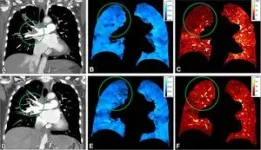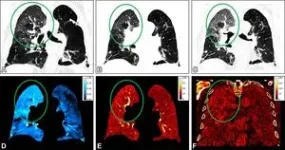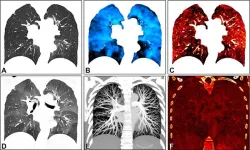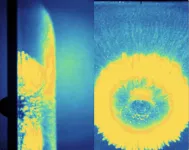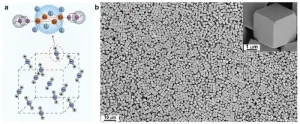(Press-News.org) BINGHAMTON, N.Y. -- A strange mystic swings a pocket watch back and forth, repeating the phrase “You’re getting sleepy, very sleepy,” giving them absolute command over their subject. That’s not how hypnotism really works, but it’s the way it’s often depicted in pop culture. Even some clinicians and hypnosis educators propagate harmful myths about hypnosis.
Steven Jay Lynn, a professor of psychology at Binghamton University, State University of New York, is an expert on hypnosis who has made major contributions to the judicial system for his insight on the practice. Lynn believes that hypnosis has many useful clinical applications, but that myths keep it from being utilized to its full potential.
In a recent paper published in BJPsych Advances, “Reconciling myths and misconceptions about hypnosis with scientific evidence,” he and his colleagues, Madeline Stein and Devin Terhune from the Institute of Psychiatry, Psychology & Neuroscience at King's College, addressed a number of errors and misconceptions regarding the characteristics and practice of hypnosis. These are a few of the common myths that are widely believed and commonly circulated in popular culture.
Hypnotized people can’t resist suggestions
A deeply hypnotized person is believed to display “blind obedience,” going along automatically with whatever the hypnotist suggests. Yet individuals do not lose control over their actions during hypnosis – contrary to the notion the media reinforces that hypnosis is something done to you and that hypnosis can be used to control someone. In fact, people can resist and even oppose hypnotic suggestions. Their experience of control during hypnosis depends on their intentions and expectations regarding whether or not they retain voluntary control.
Hypnosis is a “special state”
Hypnosis is often mischaracterized as a “special state” where defense mechanisms are reduced and a “unique state of physical relaxation and conscious unconsciousness’ allows us to ‘enter our subconscious depths through hypnosis. However, people can respond to hypnotic suggestions even while they are alert and on an exercise bicycle. Aside from being a contradiction in terms, ‘conscious unconsciousness’ is an inaccurate depiction, because during hypnosis even the most highly suggestible individuals remain fully conscious and cognizant of their surroundings. It is more accurate to consider hypnosis as a set of procedures in which verbal suggestions are used to modulate awareness, perception and cognition, rather than to unnecessarily invoke ‘special states.’
People are either hypnotizable or they are not
People’s responsiveness to hypnosis can be relatively stable over time. Yet it is inaccurate to assume that people are either hypnotizable or not. People vary greatly in their responsiveness and often respond to some suggestions but not others. Still, most people are sufficiently hypnotizable to reap substantial benefits from therapeutic suggestions.
Responsiveness to suggestions reflects nothing more than compliance or faking
Suggested behaviors during hypnosis can seem so much a departure from the mundane that questions inevitably arise regarding whether hypnotic responses are genuine. However, neuroimaging studies reveal that the effects of hypnotic suggestions activate brain regions (e.g, visual processing) consistent with suggested events (e.g., hallucinating an object).These findings provide convincing evidence that hypnotic effects are represented at the neurophysiological level consistent with what people report.
Hypnotic methods require great skill to administer
One popular misconception is that of the mesmerist, or magician-like hypnotist with special powers of influence who can “hypnotize” anyone. This widespread idea is pure myth; in actuality, administering a hypnotic induction and specific suggestions do not require any special skills or abilities beyond those required for basic social interactions and administration of experimental or clinical procedures, such as the ability to establish rapport. However, hypnosis should be practiced only by professionals trained in the use of hypnosis.
Hypnotic age regression can retrieve accurate memories from the distant past
TV shows and movies often feature people being able to recall extremely accurate memories from a distant past life under hypnosis. But research suggests a contrary view. When researchers check the accuracy of memories of people who are “age regressed” to an earlier time (e.g., 10th century) against factual information from the suggested period, they find that the information is almost invariably incorrect. What people report is mostly consistent with information experimenters provide regarding their supposed past life experiences and identities (e.g., different race, culture, sex). These findings imply that “recall” reflects participants’ expectancies, fantasies, and beliefs regarding personal characteristics and events during a given historical period.
END
You’re not getting sleepy: Six myths and misconceptions about hypnosis from an expert
2023-07-11
ELSE PRESS RELEASES FROM THIS DATE:
Obesity and high weight linked to adverse outcomes in leukemia treatment
2023-07-11
(WASHINGTON, July 11, 2023) – As the United States faces a growing obesity epidemic, scientists are taking a closer look at how body weight can affect health outcomes. New research published in Blood Advances highlights the potential association of elevated body mass index (BMI) with inferior outcomes to treatment for acute lymphoblastic leukemia (ALL) in adolescents and young adults (AYAs). This study sheds light on the impact of weight on treatment toxicities and outcomes and calls for further study of the impact of weight on response to different ALL chemotherapy regimens.
Obesity is a growing public health threat in the United States, affecting approximately ...
Photon-counting CT can evaluate lung function
2023-07-11
OAK BROOK, Ill. – New CT technology allows for a comprehensive, simultaneous evaluation of lung structure and function, something not possible with standard CT, according to a study published in Radiology, a journal of the Radiological Society of North America (RSNA).
Chest CT is the imaging method of choice for analyzing lung disease and tracking changes over time. However, CT studies of lung function and perfusion, or blood flow, require dedicated protocols that cannot be combined.
Researchers in Germany and the Netherlands developed a chest imaging protocol that yields ...
Penn Medicine researchers to lead $40 million, multisite study of Alzheimer’s disease in Asian Americans and Asian Canadians
2023-07-11
PHILADELPHIA – A $40.5 million grant from the National Institute on Aging (NIA), part of the National Institutes of Health (NIH), will fund the Asian Cohort for Alzheimer’s Disease (ACAD) study at Penn Medicine and 15 other academic research centers across the United States and Canada. Led by Li-San Wang, PhD, the Peter C. Nowell, M.D. Professor of Pathology and Laboratory Medicine in the Perelman School of Medicine at the University of Pennsylvania, the project represents the first major Alzheimer’s disease genetics cohort for Asian Americans and Asian Canadians, populations currently underrepresented in Alzheimer’s disease research. The other principal investigators ...
The moral foundations of hate speech
2023-07-11
Moral values such as purity and loyalty are often linked with hateful language, according to a study. Scholars in the field of Natural Language Processing (NLP) have in recent years focused on improving the automated detection of hate speech so such language can be removed from online spaces. But some scholars have argued that mere detection is not a real solution—that NLP can and should be used to investigate the roots of hateful language. Morteza Dehghani and colleagues conducted three studies of hateful language, looking at speeches and texts written by leaders of the Nazi party between 1933 and 1945, hateful slurs ...
Decoding the impact flash
2023-07-11
An experimental study explores the visible impact flash created by high velocity impacts. Impacts by debris and meteoroids pose a significant threat to satellites, space probes, and hypersonic craft. Such high-velocity impacts create a brief, intense burst of light, known as an impact flash, which contains information about both the target and the impactor. Gary Simpson, K.T. Ramesh, and colleagues explored the impact flash by shooting stainless steel spheres into an aluminum alloy plate, at a speed of three kilometers per second — about 6,700 miles per hour, or more than nine times the speed of sound. The resulting impact flashes were photographed ...
SwRI delivers plasma spectrometer for Moon mission
2023-07-11
SAN ANTONIO — July 11, 2023 —Southwest Research Institute has delivered a plasma spectrometer for integration into a lunar lander as part of NASA’s Lunar Vertex investigation, scheduled to commence next year. The target site is the Reiner Gamma region on the Moon’s nearside, a mysterious area known to have a local magnetic field. The SwRI-developed Magnetic Anomaly Plasma Spectrometer (MAPS) will study the interaction of the solar wind with surface materials on the Moon, aiming to understand the origin of the sinuous patterns of ...
Efficient X-ray luminescence imaging with ultrastable and eco-friendly copper(I)-iodide cluster microcubes
2023-07-11
Scintillators are optical materials that emit low-energy ultraviolet and visible photons in response to ionizing radiation such as X-rays and gamma rays. This property makes scintillating materials useful for applications like non-destructive testing, X-ray astronomy, security inspection, and medical imaging.
In a recently published paper in Light Science & Applications, Professor Xiaowang Liu and Academician Wei Huang, along with their team from the Institute of Flexible Electronics at Northwestern Polytechnical University, ...
Ohio teen and Florida veteran named first national heart health program winners
2023-07-11
DALLAS, July 11, 2023 — Two dedicated volunteers have reached a prestigious milestone with the American Heart Association, the world’s leading nonprofit organization devoted to a world of healthier lives for all, for their personal passion and commitment to advance women’s heart health.
For the third year, changemakers across the country were nominated to join the American Heart Association’s Woman of Impact and Teen of Impact® campaigns. Aligning with the Go Red for Women® movement, the Association’s signature ...
Xerces Blue butterfly genome sequenced, an icon of anthropogenic extinction
2023-07-11
The Xerces Blue butterfly (Glaucopsyche xerces) was native to the coastal dunes of San Francisco, in the United States. As the city grew, much of the butterfly’s habitat was destroyed and its population was relegated to Golden Gate National Park. Its wings were a deep iridescent blue, with characteristic white spots on the ventral side. The last surviving specimens of the species were found in 1941, by entomologist W. Harry Lange. It is considered the first insect species to have become extinct in historical times. Its disappearance has made it a global icon of anthropogenic extinction, to ...
Bacteria in kitchen may not be as harmful as you think
2023-07-11
Washington, D.C. – Bacteria found in 74 kitchens spread among 5 European countries were mostly harmless according to new research published in Applied and Environmental Microbiology, a journal of the American Society for Microbiology.
“We have previously found considerable variations in kitchen standards, food preparation practices, and cleaning regimes between France, Norway, Portugal, Romania, and Hungary,” said Birgitte Moen, Ph.D., Scientist—Department of Food Safety and Quality, Nofima—Norwegian Institute of Food, Fisheries, and Aquaculture Research, Ås, Norway.
In ...

